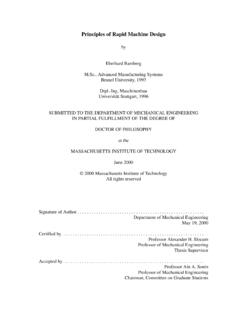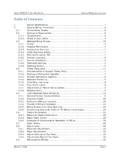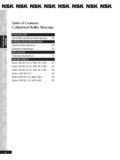Transcription of HOW TO WRITE A TECHNICAL REPORT Alan …
1 HOW TO WRITE A TECHNICAL REPORT by Alan Smithee A REPORT submitted in partial fulfillment of the requirements for ME 000 Some Course Department of Mechanical Engineering Fictitious Institute of Technology 01 January 9999 ABSTRACT Mechanics of writing a TECHNICAL REPORT is explained in a pseudo REPORT format. The purpose of this pseudo REPORT is to explain the contents of a typical engineering REPORT . It can also be used as a template for an actual engineering REPORT . With some adaptation, the format can be extended to other type of TECHNICAL writings as well. ii TABLE OF CONTENTS LIST OF FIGURES AND LIST OF EXPERIMENTAL RESULTS AND SECTION Letter of Table of List of Figures and List of Experimental Results and Conclusions and MISCELLANEOUS CONCLUSIONS AND APPENDIX A SAMPLE APPENDIX B ALTERNATIVE METHOD FOR CONDUCTION Method Method iii LIST OF FIGURES AND TABLES Figure 1 Schematic of experiment set up to do Figure 2 Quantity 1 versus Quantity Table 1 Test matrix for experiment on Table 2 Some numbers from the result of the experiment on iv LIST OF SYMBOLS r radius of a circle V volume of a sphere pi v ACKNOWLEDGEMENTS The author would like to
2 Acknowledge nobody for input in the preparation of this pseudo REPORT . However, he would like to thank Mr. Alan Smithee for lending his name to this REPORT . The name, however, is fictitious but with significance that is left for the reader to ponder. The name of the writer of this REPORT is actually Pichai Rusmee. 1 INTRODUCTION Contrary to current layman thinking that engineering works only involve working with machineries, many tasks perform by an engineer involve writing. Written communication, in fact, is an integral part of engineering tasks. The ability to WRITE a TECHNICAL REPORT in a clear and concise manner is a mark of a good engineer.
3 An engineer must be able to translate the formulae, numbers, and other engineering abstractions into an understandable written form. There are uncountable variations in engineering REPORT format. Each group, institution, company may have its own standard format to follow. This REPORT is being offered as an example of the kind of information and progression order that should be present in a sound TECHNICAL REPORT . There are certain elements common in most engineering writings. These elements can be seen in any typical engineering REPORT . A TECHNICAL REPORT must inform readers of the reasons, means, results, and conclusions of the subject matter being reported.
4 The mechanics and format of writing a REPORT may vary but the content is always similar. EXPERIMENTAL DETAILS Many engineering writing is centered on reporting of experimental works. In such a case, there should be an Experimental Details section in the REPORT . The information to be included in the experimental details section is: 1 Equipment used in the experiment. List the equipment name and model number, , Instron universal testing machine Model 4300. 2 Testing conditions. List environmental condition if it is applicable. Use and refer to figures to explain test set-ups. Figure 1 shows the test set up of nothing 2 Figure 1 Schematic of experiment set up to do nothing.
5 3 Testing parameters. Table 1 shows the test parameters used in the experiment on nothing. 4 If the test parameters are to be changed as a part of the experiment, list the different parameters in a table format. RESULTS AND DISCUSSIONS Since this REPORT is not a real REPORT , there is no result to REPORT . Table 2 list the no result that would have been in an actual REPORT . Figure 2 shows the plot of Quantity 1 versus Quantity 2. Graphs and figures should be used as necessary. Results can be reported separately before they are discussed or they can be reported as they are being discussed. Choose whichever way that is more suitable to the nature of the data being reported. SECTION DESCRIPTIONS The following is a section-by-section description of the parts in a TECHNICAL REPORT .
6 As mentioned previously, not all of the parts may be needed in a given REPORT . Table 1 Test matrix for experiment on nothing. Trial Parameter 1 Parameter 2 Parameter 3 1 1 20 2 1 15 3 2 20 OperatorPasserRecorder 3 Figure 2 Quantity 1 versus Quantity 2 Letter of transmittal A letter of transmittal is an optional part of a REPORT . It is a matter of courtesy to include one if the REPORT is being submitted for an official purpose. A letter of transmittal is addressed to the person the REPORT is intent to reach. It should include the name of the author, affiliation, title of the REPORT and purpose for its submittal. If included, a letter of transmittal will be on a separated sheet of paper not bounded to the actual REPORT .
7 Abstract An abstract of a TECHNICAL REPORT briefly summarizes the REPORT . It should describe motivations, methods, results, and conclusions. Be concise in the abstract. Think of an abstract as Table 2 Some numbers from the result of the experiment on nothing Trial # Quantity 1 Quantity 2 [unit] [unit] 1 2 3 x10-2 4 a one-paragraph summary of the REPORT . Ideally, an abstract is one paragraph long. Have a words limit, , maximum 500 words, in mind when writing an abstract. Table of Contents As the name implies, Table of Contents is the list of what is in the REPORT . Major sections of the REPORT must be listed with page numbers. Second and third level headings may also be listed as appropriated.
8 Think of revising the structure of the REPORT if fourth level heading is important enough to be listed in the Table of Contents. Index and feature in a word processor is the quickest way to automatically build the Table of Contents in a REPORT . List of Figures and Tables This section contains two related but separate lists. List of Figures contains the listing of all the figures (drawings and graphs) that appear in the REPORT . They are listed in consecutive order that they appear in the REPORT with figure captions and page number. List of Tables is similar to the List of Figures but for all the tables that appear in the REPORT . List of Symbols This list is optional.
9 It can be used if the REPORT contains a lot of formulae and symbols. The readers often appreciate a list explaining the sympols used in the REPORT . Acknowledgements The author(s) must acknowledge every person or agency involved in funding, guiding, advising, and working on the project that are not part of the authoring team. Failure to acknowledge someone contributing to the project is a serious breach of etiquette and may be construed as plagiarism, a very serious offense. Traditionally, editor, proofreader, and fact 5 checkers are not included among those acknowledged. Introduction The beginning of the introduction should quickly explain the importance of the experiment being reported.
10 Simply say that something is important is not adequate. The author must make a case for it. If there is no separate TECHNICAL Background section in the REPORT , this section is where the necessary concepts that were applied in order to obtain the results are explained. An assumption must be made regarding the TECHNICAL level of the readers. Assume that the readers already possess TECHNICAL ability to understand the material then present the TECHNICAL information accordingly. Do not attempt to WRITE an introductory text on the subject. Nor should the writer assume that the readers are experts in the subject. Experimental Details This is the section where details of the experiments or research conducted are discussed.








